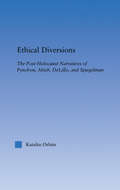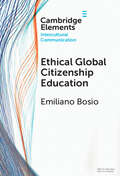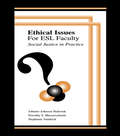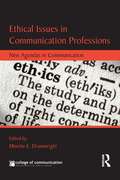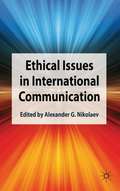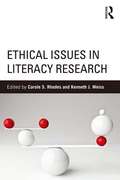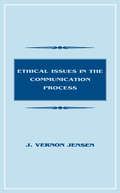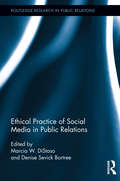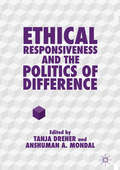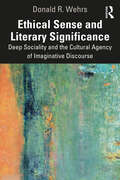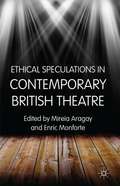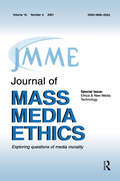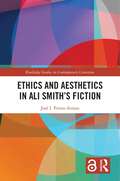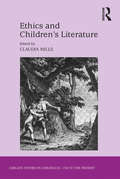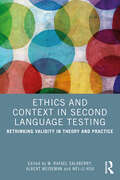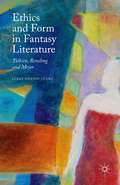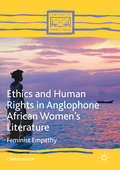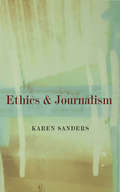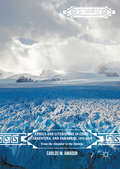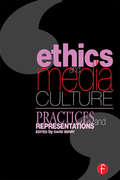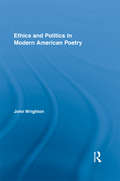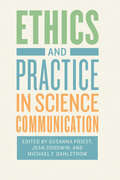- Table View
- List View
Ethical Diversions: The Post-Holocaust Narratives of Pynchon, Abish, DeLillo, and Spiegelman (Literary Criticism and Cultural Theory)
by Katalin OrbanFirst Published in 2005. Routledge is an imprint of Taylor & Francis, an informa company.
Ethical Futures and Global Science Fiction (Studies in Global Science Fiction)
by Zachary Kendal Aisling Smith Giulia Champion Andrew MilnerEthical Futures and Global Science Fiction explores the ethical concerns and dimensions of representations of the future of global science fiction, focusing on the issues that dominate utopian, dystopian and science fiction literature. The essays examine recent visions of the future in science fiction and re-examine earlier texts through contemporary lenses. Across fourteen chapters, the collection considers authors from Algeria, Australia, Canada, China, Egypt, France, Germany, Haiti, India, Jamaica, Macedonia, Mexico, Russia, South Africa, the UK and USA. The volume delves into a range of ethical questions of immediate contemporary relevance, including environmental ethics, postcolonial ethics, social justice, animal ethics and the ethics of alterity.
Ethical Global Citizenship Education (Elements in Intercultural Communication)
by Emiliano T. BosioGlobal Citizenship Education (GCE) plays a central role within UNESCO's education sector, focusing on cultivating the values and knowledge essential for students to evolve into well-informed and responsible global citizens. This Element conceptualises an ethical GCE framework grounded in critical, cosmopolitan, humanistic, value-creating, and transformative principles. Guided by those principles, ethical GCE goes beyond the banking model of education by emphasising a global ethic. Ethical GCE is inclusive, ethically reflective, and socially responsible. It extends beyond imparting knowledge and employable skills, important as they are, focusing on holistic and sustainable development. With further theoretical development and implementation strategies, the ethical GCE framework holds promise for future research and evaluation of the intricate teaching and learning processes within global citizenship, particularly from a values-based perspective.
Ethical Issues for Esl Faculty: Social Justice in Practice
by Johnnie Johnson Hafernik Stephanie Vandrick Dorothy S. MesserschmittThis book explicitly addresses ethical dilemmas and issues that post-secondary ESL faculty commonly encounter and examines them in the framework of social justice concerns. Ethics is defined broadly, to include responsibilities and obligations to students inside and outside the classroom, as well to colleagues, educational institutions, the TESL profession, and society as a whole. Scenarios in each chapter provide realistic and compelling situations for reflection and discussion. The authors then set out the issues raised, relate them to the classroom environment, and offer opportunities to examine them in a variety of contexts and to consider possible solutions to the dilemmas. Issues include testing, plagiarism, technology, social and political issues affecting students and the classroom, gift-giving, curriculum decisions, disruptive students, institutional constraints, academic freedom, gender, class, and power. Busy classroom instructors will find this book accessible, thought-provoking, and relevant to their daily work situations. It is not intended as a theoretical treatment of ethics and social justice in ESL, nor does it propose that ESL faculty teach morals or ethics to students. Rather, it is designed as a concise, practical introduction to ethical practice for both new and experienced ESL faculty in post-secondary teaching situations in the United States, for others interested in the ESL classroom, and as a text for TESL classes and seminars. Ethical Issues for ESL Faculty: *maps new territory in the field--ethical issues in TESL, particularly as encountered by post-secondary classroom teachers, are not often discussed in ESL publications; *makes the complex issues of ethics in the context of social justice accessible to TESL practitioners; and *includes useful resources, such as additional scenarios for discussion, an extensive reference list, and selected ethics-related Web sites.
Ethical Issues in Communication Professions: New Agendas in Communication (New Agendas in Communication Series)
by Minette E. DrumwrightDynamic, rapid, and radical changes are transforming the communication professions, provoking major implications for ethics. Traditional boundaries blur as media converge; relentless competitive pressures cause some forms of communication to atrophy and permit others to explode; and technological advances occur daily. In this volume, a new generation of scholars take a fresh look at the manner in which ethical issues manifest themselves in their areas of research and suggest new agendas for future research. This book addresses a wide range of questions from a variety of communication professions. Contributors tackle such issues as how to define a journalist in an era when anyone can disseminate information to a global audience; how to use "advergames," crowdsourcing, and facial recognition technology in advertising responsibly; and how to respond ethically in situations of public crisis communication, among many others. This volume will be critical reading for scholars and professionals in media, communication, and digital arts, as well as philosophy, government, public policy, business, and law.
Ethical Issues in International Communication
by Alexander G. NikolaevThisunique collectionexplores contemporary ethical issues and problems in international communication. Written by scholars from around the world focusing on global ethical issues for a global audience, the volume considers theoretical issues of international communication ethics and provides specific practical examples and case studies. Key areas within the field of international communication are discussed, includingjournalism, international PR and public communication, political rhetoric andeducation, making this an important inclusion to the current literature. "
Ethical Issues in Literacy Research
by Carole S. Rhodes Kenneth J. WeissLiteracy educators and researchers at all stages of their careers face ethical issues whenever they embark on research studies. In this book experienced literacy researchers identify and address multi-faceted, multi-dimensional ethical issues related to conducting studies in school, home, community, and virtual settings and share actions taken when faced with ethical dilemmas in their own investigations. Each chapter addresses a specific literacy research ethical issue. Part I focuses on conducting research in settings such as schools or literacy clinics. Part Two addresses research with pre-service teachers in college/university and school settings. Part Three looks at research in virtual worlds and online environments. Pedagogical features in each chapter engage readers in making connections between what they are reading and their own teaching and learning situations: A vignette to help readers understand the issue; pre-reading questions ; background information drawn from current research literature; suggested engagement activities; chapter summary. Additional resources (PowerPoint Presentations; Case Studies; Website Links; Interactive "Ask the Researcher Websites/Blogs/Tweets") are available on a website linked to the book: www.LiteracyResearchEthics.com
Ethical Issues in the Communication Process (Routledge Communication Series)
by J. Vernon JensenA rapid and widespread growth of interest in applied ethics is occurring today not only in the United States, but around the world as well. Academia both reflects this and is a leader in the movement. The field of speech communication shares in this increased sensitivity to ethical concerns. Students and the general public are looking for thoughtful analyses and guidance in all areas of communication. Ethical concerns relative to mass communication have been the subject of a number of books, but only a very few cover the entire scope of communication to include interpersonal, intercultural, organizational, small groups, and public speaking. This book tries to fill that need by discussing ethical concerns as they emerge in the areas of the communication process -- the communicator, the message, the media, the audience, and the situation. The speech communication field now has a need to digest and synthesize the existing research findings and the general literature in the field and in related humanities and social science works into a coherent and nontechnical discussion. This volume explores the most up-to-date materials to provide just such a synthesis. An extensive bibliography at the end of the book gives readers the sources on which the book is based, and offers ample avenues for further personal exploration. The book should provide meaningful food for thought as readers grapple conscientiously with the many everyday decisions made in communication transactions, and in evaluating the communication of others.
Ethical Journalism: Adopting the Ethics of Care
by Joe MathewsonThis book makes the case for the news media to take the lead in combatting key threats to American society including racial injustice, economic disparity, and climate change by adopting an "ethics of care" in reporting practices. Examining how traditional news coverage of race, economics and climate change has been dedicated to straightforward facts, the author asserts that journalism should now respond to societal needs by adopting a moral philosophy of the "ethics of care," opening the door to empathetic yet factual and fair coverage of news events, with a goal to move public opinion to the point that politicians are persuaded to take effective action. The book charts a clear path for how this style of ethics can be applied by today’s journalists, tracing the emergence of this empathy-based ethics from feminist philosophy in the 1980s. It ultimately urges ethical news organizations to adopt the ethics of care, based on the human emotion prioritized by Scottish Enlightenment philosopher David Hume, and to pursue a more pro-active, solutions-seeking coverage of current events. This is an invaluable text for students and academics in the fields of journalism ethics, media ethics and media law, as well as for media professionals looking for a fresh perspective on practicing ethical journalism.
Ethical Practice of Social Media in Public Relations (Routledge Research in Public Relations)
by Marcia W. DiStaso Denise Sevick BortreeGiven the high rate of social media use by the public, organizations are compelled to engage with key audiences through these outlets. Social media engagement requires organizations to actively participate with public groups, and this highly-interactive exchange raises a new set of ethical concerns for communicators. In this rapidly changing communications environment, the long-term implications of social media are uncertain, and this book provides the much needed research to understand its impact on audiences and organizations. Through an examination of a broad range of ethics concepts including transparency and online identities, policies, corporate responsibility, and measurement, this book explores a variety of topics important to public relations such as diversity, non-profit communication, health communication, financial communication, public affairs, entertainment communication, environmental communication, crisis communication, and non-profit communication. The chapter authors, expert scholars within their fields of public relations, offer insights drawn from original research and case study examples of ethical dilemmas raised by social media communication.
Ethical Responsiveness and the Politics of Difference
by Anshuman A. Mondal Tanja DreherThis edited collection focuses on the ethics, politics and practices of responsiveness in the context of racism, inequality, difference and controversy. The politics of difference has long been concerned with speech, voice and representation. By focusing on the practices and politics of responsiveness—listening, reading and witnessing—the volume identifies vital new possibilities for ethics and social justice. Chapters focus on the conditions of possibility, or listening as ethical praxis; unsettling or disrupting colonial relationships; and ways of listening that highlight non-Western traditions and move beyond the liberal frame. Ethical responsiveness shifts some of the responsibility for negotiating difference and more just futures from subordinated speakers, and on to the relatively more privileged and powerful.
Ethical Sense and Literary Significance: Deep Sociality and the Cultural Agency of Imaginative Discourse
by Donald R. WehrsThis study blends together ethical philosophy, neurocognitive-evolutionary studies, and literary theory to explore how imaginative discourse addresses a distinctively human deep sociality, and by doing so helps shape cultural and literary history. Deep sociality, arising from an improbable evolutionary history, both entwines and leaves non-reconciled what is felt to be significant for us and what ethical sense seems to call us to acknowledge as significant, independent of ourselves. Ethical Sense and Literary Significance connects literary and cultural history without reducing the literary to a mere expression of something else. It argues that affective differences between non-egocentric and egocentric registers of significance are integral to the bioculturally evolved deep sociality that verbal art addresses—often in unsettling and socially critical ways. Much imaginative discourse, in early societies as well as recent ones, brings ethical sense and literary significance together in ways that reveal their intricate but non-harmonized internal entwinement. Drawing on contemporary scholarship in the humanities and sciences, Donald R. Wehrs explores the implications of interdisciplinary approaches to topics central to a wide range of fields beyond literary studies, including neuroscience, anthropology, phenomenological philosophy, comparative history, and social psychology.
Ethical Speculations in Contemporary British Theatre
by Mireia Aragay Enric MonforteThis volume is the first to offer a comprehensive critical examination of the intersections between contemporary ethical thought and post-1989 British playwriting. Its coverage of a large number of plays and playwrights, international range of contributors and original argumentation make it a key point of reference for students and researchers.
Ethics & New Media Technology: A Special Issue of the journal of Mass Media Ethics
by Lawrence ErlbaumThis special issue shows that "old ethics" don't always provide ready answers to problems raised by new technology. Exploring the perplexing topic of ethics in new media, this special issue: *examines the ethics of the highly controversial 1998 Cincinnati Enquirer exposé of Chiquita Brands International; *reports on a pilot project involving online journalists and online journalism graduate students; *investigates the extent to which e-mail and listservs are--and could be--effective fora for journalists interested in exploring matters of ethics; and *provides a useful annotated webliography of information resources.
Ethics and Aesthetics in Ali Smith’s Fiction (Routledge Studies in Contemporary Literature)
by José I. Prieto-ArranzThis study offers a fresh perspective on Ali Smith’s work, analysing her fiction through a truly interdisciplinary lens. José I. Prieto-Arranz explores Smith’s engagement with contemporary issues such as digital violence, disinformation, pornography, nationalism, climate change, discrimination, and social fracture. Simultaneously, this book examines Smith’s unique stylistic choices, including her use of magical realism, intertextuality, and intermediality, to reveal the intricate connection between the ethical and aesthetic dimensions of her novels. Through close readings of Smith’s novels, from Like to Companion Piece, enriched with insights from her prolific short fiction, the author demonstrates how Smith constructs a “text continuum,” revealing recurrent themes and stylistic choices that underline her firm belief in the transformative power of fiction and, by extension, art. This book will appeal to scholars of contemporary literature, art theory, political science, sociology and cultural studies, and anyone interested in literature and social commentary.
Ethics and Children's Literature (Studies in Childhood, 1700 to the Present)
by Claudia MillsExploring the ethical questions posed by, in, and about children’s literature, this collection examines the way texts intended for children raise questions of value, depict the moral development of their characters, and call into attention shared moral presuppositions. The essays in Part I look at various past attempts at conveying moral messages to children and interrogate their underlying assumptions. What visions of childhood were conveyed by explicit attempts to cultivate specific virtues in children? What unstated cultural assumptions were expressed by growing resistance to didacticism? How should we prepare children to respond to racism in their books and in their society? Part II takes up the ethical orientations of various classic and contemporary texts, including 'prosaic ethics' in the Hundred Acre Wood, moral discernment in Narnia, ethical recognition in the distant worlds traversed by L’Engle, and virtuous transgression in recent Anglo-American children’s literature and in the emerging children’s literature of 1960s Taiwan. Part III’s essays engage in ethical criticism of arguably problematic messages about our relationship to nonhuman animals, about war, and about prejudice. The final section considers how we respond to children’s literature with ethically focused essays exploring a range of ways in which child readers and adult authorities react to children’s literature. Even as children’s literature has evolved in opposition to its origins in didactic Sunday school tracts and moralizing fables, authors, parents, librarians, and scholars remain sensitive to the values conveyed to children through the texts they choose to share with them.
Ethics and Context in Second Language Testing: Rethinking Validity in Theory and Practice
by Albert Weideman M. Rafael Salaberry Wei-Li HsuThis innovative, timely text introduces the theory and research of critical approaches to language assessment, foregrounding ethical and socially contextualized concerns in language testing and language test validation in today’s globalized world. The editors bring together diverse perspectives, qualitative and quantitative methodologies, and empirical work on this subject that speak to concerns about social justice and equity in language education, from languages and contexts around the world – offering an overview of key concepts and theoretical issues and field-advancing suggestions for research projects. This book offers a fresh perspective on language testing that will be an invaluable resource for advanced students and researchers of applied linguistics, sociolinguistics, language policy, education, and related fields – as well as language program administrators.
Ethics and Enjoyment in Late Medieval Poetry
by Jessica RosenfeldJessica Rosenfeld provides a history of the ethics of medieval vernacular love poetry by tracing its engagement with the late medieval reception of Aristotle. Beginning with a history of the idea of enjoyment from Plato to Peter Abelard and the troubadours, the book then presents a literary and philosophical history of the medieval ethics of love, centered on the legacy of the Roman de la Rose. The chapters reveal that 'courtly love' was scarcely confined to what is often characterized as an ethic of sacrifice and deferral, but also engaged with Aristotelian ideas about pleasure and earthly happiness. Readings of Machaut, Froissart, Chaucer, Dante, Deguileville and Langland show that poets were often markedly aware of the overlapping ethical languages of philosophy and erotic poetry. The study's conclusion places medieval poetry and philosophy in the context of psychoanalytic ethics, and argues for a re-evaluation of Lacan's ideas about courtly love.
Ethics and Form in Fantasy Literature: Tolkien, Rowling and Meyer
by Lykke Guanio-UluruEthics and Form in Fantasy Literature: Tolkien, Rowling and Meyer by Lykke Guanio-Uluru examines formal and ethical aspects of The Lord of the Rings , Harry Potter and the Twilight series in order to discover what best-selling fantasy texts can tell us about the values of contemporary Western culture.
Ethics and Human Rights in Anglophone African Women’s Literature
by Chielozona EzeThis book is about feminist empathy as a model of interpretation in the works of contemporary Anglophone African women writers. The African woman's body is often portrayed as having been disabled by the patriarchal and sexist structures of society. Returning to their bodies as a point of reference, rather than the postcolonial ideology of empire, contemporary African women writers demand fairness and equality. By showing how this literature deploys imaginative shifts in perspective with women experiencing unfairness, injustice, or oppression because of their gender, Chielozona Eze argues that by considering feminist empathy, discussions open up about how this literature directly addresses the systems that put them in disadvantaged positions. This book, therefore, engages a new ethical and human rights awareness in African literary and cultural discourses, highlighting the openness to reality that is compatible with African multi-ethnic, multi-racial, and increasingly cosmopolitan communities.
Ethics and Journalism
by Dr Karen SandersWhat are ethics? Why does ethical journalism matter? How do ethics affect good journalism? Ethics and Journalism provides a comprehensive overview of the main approaches to ethical enquiry in Western journalism. It examines the ethical dilemmas faced by journalists in all areas of the media and sets our ways of achieving ethical journalism. Ethics and Journalism: - Explores such subjects as: private lives and the public interest, relations to sources and coverage of death, disease and destruction - Examines the role of regulation and self-regulation of the media industry - Discusses strategies of good journalism - Thoroughly examines the role of industry codes. Ethics and Journalism is informed by interviews with top journalists and editors and is written in a clear and accessible style. It includes an exhaustive bibliography as well as an excellent list of relevant web-sites. It will be essential reading for all journalism, media and politics students studying journalism and ethics, as well as for those who already work in the media and are interested in understanding ethical issues.
Ethics and Literature in Chile, Argentina, and Paraguay, 1970-2000
by Carlos M. AmadorThis book argues for a new reading of the political and ethical through the literatures of Argentina, Chile, and Paraguay from 1970-2000. Carlos Amador reads a series of examples from the last dictatorship and the current post-dictatorship period in the Southern Cone, including works by Augusto Roa Bastos, Roberto Bolaño, Ceferino Reato, Horacio Verbitsky, Nelly Richard, Diamela Eltit, and Willy Thayer, with the goal of uncovering the logic behind their conceptions of belonging and rejection. Focusing on theoretical concepts that make possible the formation of any and all communities, this study works towards a vision of literature as essential to the structure of ethics.
Ethics and Media Culture: Practices and Representations
by David BerryEthics and Media Culture straddles the practical and ethical issues of contention encountered by journalists. The book's various contributors cover a diversity of issues and viewpoints, attempting to broaden out the debates particularly in relation to Journalism Studies, Cultural Studies, Sociology of Culture and Communications, Philosophy and History. The debate concerning media ethics has intensified in recent years, fuelled mainly by the standards of journalist and media practices. The role of practitioners has taken centre-stage as concerns over what constitutes ethical, and therefore socially acceptable practice and behaviour, by the public, practitioners and intellectuals alike. The discursive relationship between the production and consumption of information is central to the debate regarding moral conduct, particularly in light of the commercialisation of the media. Considering that media institutions operate in a climate of intense competition, the value of information and its corresponding quality have begun to be critically assessed in terms of ethical understanding. A degree of open-endedness is maintained in discussions throughout this book, which is intended to engage the reader with the issues raised and determine their own conclusions.
Ethics and Politics in Modern American Poetry (Literary Criticism and Cultural Theory)
by John WrightonFrom the Objectivists to e-poetry, this thoughtful and innovative book explores the dynamic relationship between the ethical imperative and poetic practice, revitalizing the study of the most prominent post-war American poets in a fresh, provocative way. Contributing to the "turn to ethics" in literary studies, the book begins with Emmanual Levinas’ philosophy, proposing that his reorientation of ontology and ethics demands a social responsibility. In poetic practice this responsibility for the other, it is argued, is both responsive to the traumatized semiotics of our shared language and directed towards an emancipatory social activism. Individual chapters deal with Charles Olson’s The Maximus Poems (including reproductions of previously unpublished archive material), Gary Snyder’s environmental poetry, Allen Ginsberg’s Beat poetics, Jerome Rothenberg’s ethnopoetics, and Bruce Andrew’s Language poetry. Following the book’s chronological and contextual approach, their work is situated within a constellation of poetic schools and movements, and in relation to the shifting socio-political conditions of post-war America. In its redefinition and extension of the key notion of "poethics" and, as guide to the development of experimental work in modern American poetry, this book will interest and appeal to a wide audience.
Ethics and Practice in Science Communication
by Susanna Priest Jean Goodwin Michael F. DahlstromFrom climate to vaccination, stem-cell research to evolution, scientific work is often the subject of public controversies in which scientists and science communicators find themselves enmeshed. Especially with such hot-button topics, science communication plays vital roles. Gathering together the work of a multidisciplinary, international collection of scholars, the editors of Ethics and Practice in Science Communication present an enlightening dialogue involving these communities, one that articulates the often differing objectives and ethical responsibilities communicators face in bringing a range of scientific knowledge to the wider world. In three sections—how ethics matters, professional practice, and case studies—contributors to this volume explore the many complex questions surrounding the communication of scientific results to nonscientists. Has the science been shared clearly and accurately? Have questions of risk, uncertainty, and appropriate representation been adequately addressed? And, most fundamentally, what is the purpose of communicating science to the public: Is it to inform and empower? Or to persuade—to influence behavior and policy? By inspiring scientists and science communicators alike to think more deeply about their work, this book reaffirms that the integrity of the communication of science is vital to a healthy relationship between science and society today.
